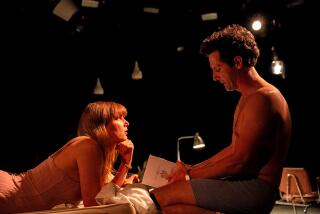Drama, Then Balance
- Share via
Because their scenes together in Showtime’s “Wild Iris” were so intensely dramatic, stars Laura Linney and Gena Rowlands kept the mood on the set light and funny.
“We had fun,” says Linney, a recent Oscar nominee for “You Can Count on Me.” “You have to when you are doing movies like this because you just can’t bottom out and go to the depths of psychological drama without something on the other side balancing it.”
For the record:
12:00 a.m. Aug. 4, 2001 FOR THE RECORD
Los Angeles Times Saturday August 4, 2001 Home Edition Part A Part A Page 2 A2 Desk 1 inches; 25 words Type of Material: Correction
Director’s name--The TV movie “Wild Iris” was directed by Daniel Petrie Sr. A story about the film in Thursday’s Calendar Weekend mistakenly credited his son as the director.
Directed by Daniel Petrie Jr. (“Fort Apache, the Bronx,” Showtime’s “Inherit the Wind”), “Wild Iris,” which premieres Sunday, focuses on the toxic relationship between Minnie (Rowlands) and her daughter Iris (Linney), which is further strained when the two end up working and living together in their bridal boutique-home. Mother and daughter end up bickering so much, they both fail to realize Iris’ teenage son Lonnie (Emile Hirsch) is contemplating suicide as a way out of the dysfunctional family.
“When you are doing something so dramatic, the relief in between the scenes makes you sometimes be funnier than you would be normally,” says the veteran Rowlands (“Woman Under the Influence,” “The Betty Ford Story”). “So we really had a great time.”
Rowlands said writer Kent Broadhurst captured in Minnie how “people who are absolutely committed to their point of view have no idea the havoc and tragedy that can come from just being so unbending,” she says.
“They just refuse to see it,” Rowlands continued. “It makes you very strong in one way. My character was a great survivor, but at what cost?”
It was the complexity and truthfulness of Broadhurst’s script that drew Linney to the project. “The story was very rich and a real challenge to pull off in many different levels--the storytelling of it and the acting of it. There were a lot of things that were difficult and potentially problematic. Those things are always alluring to see if you can actually make something work.”
In the case of Iris--who bitterly blames Minnie for the suicide of her husband eight years earlier--Linney realized her character could have been painfully one-note. “I tried to layer it in a way that you could get a sense of her as a well-rounded person and not just one mood the whole time.”
Truth be told, Linney says, “you want them all to get to a shrink because they are very intelligent people who do love each other ... but they just cannot deal with each other. There have been transgressions made. There was a feeling of disloyalty and betrayal and deep personal hurt. They don’t have the facility to deal with it.”
Linney decided to dye her blond hair a dark brown for her role. “It just didn’t make sense to me for her to be blond,” says the actress. “I wanted her to look a little like she had been around the block. So I thought the dark hair would work. I didn’t want to wear any makeup at all and, happily, [the producers] were really good about that.”
Rowlands may have admired Minnie’s survival skills, but she didn’t like her. “I don’t think you have to like a character to play them,” she says. And she certainly knew someone like Minnie--her grandmother. “My grandmother easily could have been a candidate for the meanest woman in the world, and my mother--the thing that amazed me is that my mother was so gay and funny and kind. I often wondered how she escaped my grandmother, who was so unyielding. My mother was so sociable and outgoing. She turned out to be the most extraordinary woman.”
Both actresses enjoyed working with director Petrie. In fact, Petrie and Rowlands worked together in live television in the ‘50s.
“Dan is extremely smart in how he handled those really big, intense scenes,” says Linney. “He would film them in tiny little sequences. Normally, you film them in big chunks. He really broke it down. I never worked that way before. It made the day much less exhausting.”
“Wild Iris” is really the little movie that could. It took more than 10 years for the intimate drama to find a home on the small screen. Even Showtime had twice passed on “Wild Iris” before finally bowing to producer Kevin Goetz’s tenacity. “Everyone said if you stick to it long enough you’ll get it made ... I sort of feel like I willed it to happen.”
‘Alive, Funny, Biting’
Goetz was the artistic director and producer of the Central Coast Repertory Theatre in San Luis Obispo when he held a staged reading of a play, “Black Iris,” by Broadhurst. Goetz felt the drama had a “Steel Magnolias” and “Fried Green Tomatoes” sensibility and would work better as a movie.
“Kent Broadhurst’s words were so alive and funny and biting and deep and emotional and heart-wrenching,” says Goetz.
Petrie got involved with “Wild Iris” six years ago after Goetz gave him the screenplay over a luncheon meeting. A few years later, producer Gary Lucchesi came on board. Lucchesi had worked with Linney on “Primal Fear” and approached her about doing this.
“Laura was steadfast all the time when we were having trouble getting the money,” says Petrie. “The budget was more than the distributors wanted to pay.”
Since Petrie had done the well-respected “Inherit the Wind” for Showtime, the director approached the cable network’s president, Jerry Offsay, who agreed to look at the script again. He eventually told Petrie if he could deliver the right actresses, the network would greenlight the film.
With Linney on board, Petrie approached Rowlands. “She was very enthusiastic and signed on right away,” says Petrie. “We were off and running.”
*
“Wild Iris” can be seen Sunday at 8 p.m. on Showtime. The network has rated it TV-14 (may be unsuitable for children younger than 14).
More to Read
Only good movies
Get the Indie Focus newsletter, Mark Olsen's weekly guide to the world of cinema.
You may occasionally receive promotional content from the Los Angeles Times.











